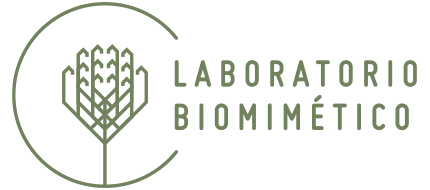What if we designed cooperative cities capable of functioning like an ecosystem?
Are new models of life that promote cooperation and biodiversity possible?

Talking about biomaterials at Anceu Coliving
In the context of sustainable planning and urbanism, it is crucial to consider not only the management of energy and natural resources but also the equitable distribution of social and economic resources within communities. Social relationships, collaborative economy, and new forms of living together play a vital role in creating sustainable urban environments. John Thackara’s approach in his book «How to Thrive in the Next Economy: Designing Tomorrow’s World Today» emphasizes the importance of prioritizing the vitality of social goals and ecological systems in urban planning. This means supporting initiatives that foster social creativity and promote the common good in cities. Projects such as collaborative maker spaces, community recycling programs, productive urban gardens, and shared dining spaces are examples of initiatives that strengthen social bonds and promote environmental sustainability. These initiatives not only contribute to local economic development but also foster a sense of community and belonging among urban residents.
In recent years, new forms of living have emerged that reflect changes in lifestyles and social needs. Among these modalities are coworking and coliving spaces, as well as cohousing models.
During our days at Anceu Coliving, we had the opportunity to experience coliving from the inside. Anceu Coliving is not just a residential community where people share common areas like kitchens, living rooms, and social spaces, in addition to common workspaces, while maintaining private spaces for sleeping and resting. This rural community not only provides accommodation but also a social network and collaboration opportunities, becoming increasingly popular among digital nomads and young professionals seeking a more flexible and communal lifestyle.
The idea of coliving can be compared to the functioning of a natural ecosystem, like a forest. In a forest, each element plays a crucial role and benefits from the other elements, creating an interdependent and resilient system. Similarly, colivings foster cooperation, interdependence, and mutual support among their members, leading to a stronger and more cohesive community. Instead of relying on individualistic consumption and unsustainable built environments, we could create communities where cooperation and biodiversity are fundamental pillars.
Integrating colivings into rural areas adds an additional dimension of value. By connecting with the rural environment, these communities benefit from direct contact with nature and have the opportunity to revitalize areas that often suffer from depopulation and lack of resources. This integration allows residents to actively engage in local life, creating synergies with the inhabitants and contributing to the economic and social development of the area. Creating community in a rural environment involves generating a positive and tangible impact on the territory. Colivings can serve as centers of innovation and creativity, attracting professionals and entrepreneurs who want to work in an inspiring and collaborative setting. These spaces can facilitate the transfer of knowledge and skills between new residents and the local population, fostering entrepreneurship and creating new job opportunities.
In our experience living with the Anceu Coliving community, we have learned that creating value in the rural environment through colivings reflects the ability to generate community projects that include all the territory’s actors, from circular economy and responsible consumption initiatives to educational and cultural programs that strengthen social bonds and enrich community life. At the same time, colivings in rural areas can promote sustainable and environmentally friendly practices by implementing solutions such as regenerative agriculture, the use of renewable energy, and responsible natural resource management. In doing so, not only is the quality of life of the residents improved, but the natural and cultural heritage of the territory is also preserved and valued.
The week of exchange.
During these days, we had the opportunity to visit various creative hubs and meet people who have launched different cultural and creative initiatives. Our tour began with a visit to Espacio Arroelo Coworking (part of the European Creative Hubs Network), , and Reclamos studio, where we shared our research on new biomaterial realities and disseminated the vision and mission we carry out at Laboratorio Biomimético, always taking Nature as a reference and inspiration for innovation. Additionally, we continued our visits to other impactful local projects, including the Mercado de Tía Ni and Casa Nagarola. These places are not only catalysts for rural development but also energizers of the community. From each of these spaces and their managers, we learned valuable lessons about how community initiatives can significantly impact the revitalization of rural areas. The strategies employed, centered on cooperation and sustainability, deeply inspired us and provided us with new perspectives and collaboration possibilities to apply in our own environment and future projects.
At the same time, during our stay at the coliving, we contributed a series of workshops focused on natural pigments and biomaterials. In these workshops, the residents of Anceu Coliving were able to discover how to extract and use natural pigments, exploring innovative and sustainable techniques for their application in different creative projects. Additionally, we had the opportunity to explore the environment through wonder and biomimicry, discovering the potential of the location of Anceu Coliving. Through activities of observation and reflection, we promoted a deeper connection with nature and a broader understanding of how its processes can inspire sustainable innovations. All this resulted in an exchange of ideas and experiences that will undoubtedly strengthen future innovation and sustainability initiatives within the community, promoting a more collaborative and ecological approach to the projects that arise from this collaboration.
Final Event.
On Saturday, the village of Anceu came alive with A Fuchiqueira, an intergenerational event designed to inspire creativity and foster community ties. Held at the communal house, the event featured a blend of art, technology, and culinary delights, reflecting the diverse interests and expertise of the participants.
The event began with a presentation about our activity and experience at Laboratorio Biomimético, followed by a workshop on biomaterial manufacturing. Each person was able to experiment with different ingredients, waste materials, and techniques, while also understanding the circular and regenerative manufacturing processes implemented by organisms in Nature.
Simultaneously, other maker activities were conducted such as:
An introduction to 3D printing technology, with practical demonstrations.
Demonstrations and practices of laser cutting.
Workshops on creating solargraphs using simple soda cans.
Learning about website construction with WordPress.
The event concluded with a communal dinner, where participants enjoyed international dishes prepared by other attendees, accompanied by traditional regional music, creating an atmosphere for cultural exchange and networking, strengthening community ties and fostering new connections.
A Fuchiqueira demonstrated the synergy between collaboration and innovation in rural development. Upon conclusion of the event, participants acquired:
1. Development of technical skills: Through workshops and presentations, they gained knowledge in technology, art, and sustainability, essential for addressing challenges in rural environments.
2. Strengthening of community and professional connections: Interaction among participants consolidated bonds and created a network of potential collaborators with shared objectives.
3. Inspiration to innovate in rural projects: Shared experiences spurred the generation of new ideas and approaches for more effective and sustainable rural projects.
4. Identification of future collaboration opportunities: Connections were established among entities such as Anceu Coliving and Laboratorio Biomimético, as well as other rural hubs, laying a solid foundation for collaborations that maximize positive impact in rural development.
Acknowledgments.
We want to express our deep gratitude to the European Creative Hubs Network (ECHN) for their generous funding through the P2P program, which has been fundamental to the success of this exchange. Their support has enabled Anceu Coliving and the Laboratorio Biomimético to join forces to drive innovation in rural environments.
This exchange has set a significant precedent for future collaborations, highlighting the importance of collaboration among different entities to promote sustainable and innovative rural development. We are committed to continuing to work closely with ECHN and other related organizations to explore new opportunities and develop projects that benefit our communities.
Looking ahead, we are excited to continue advancing together towards a vibrant, sustainable, and innovative rural future. We are confident that future collaborations between Anceu Coliving, the Laboratorio Biomimético, and other key stakeholders will remain crucial in driving positive change in our rural landscapes.


